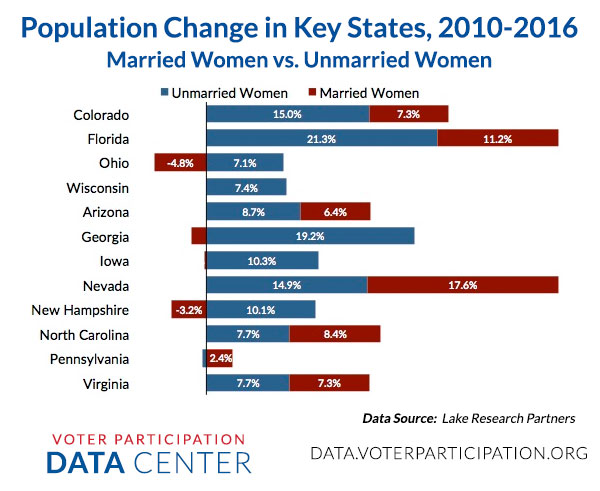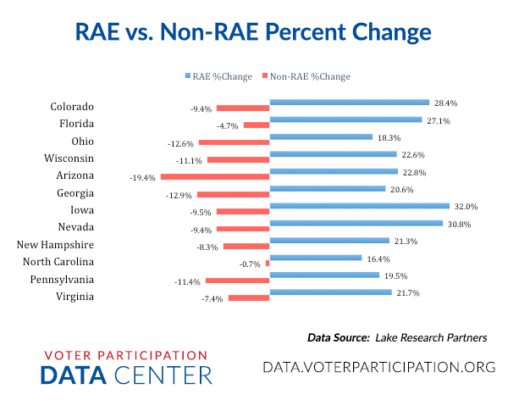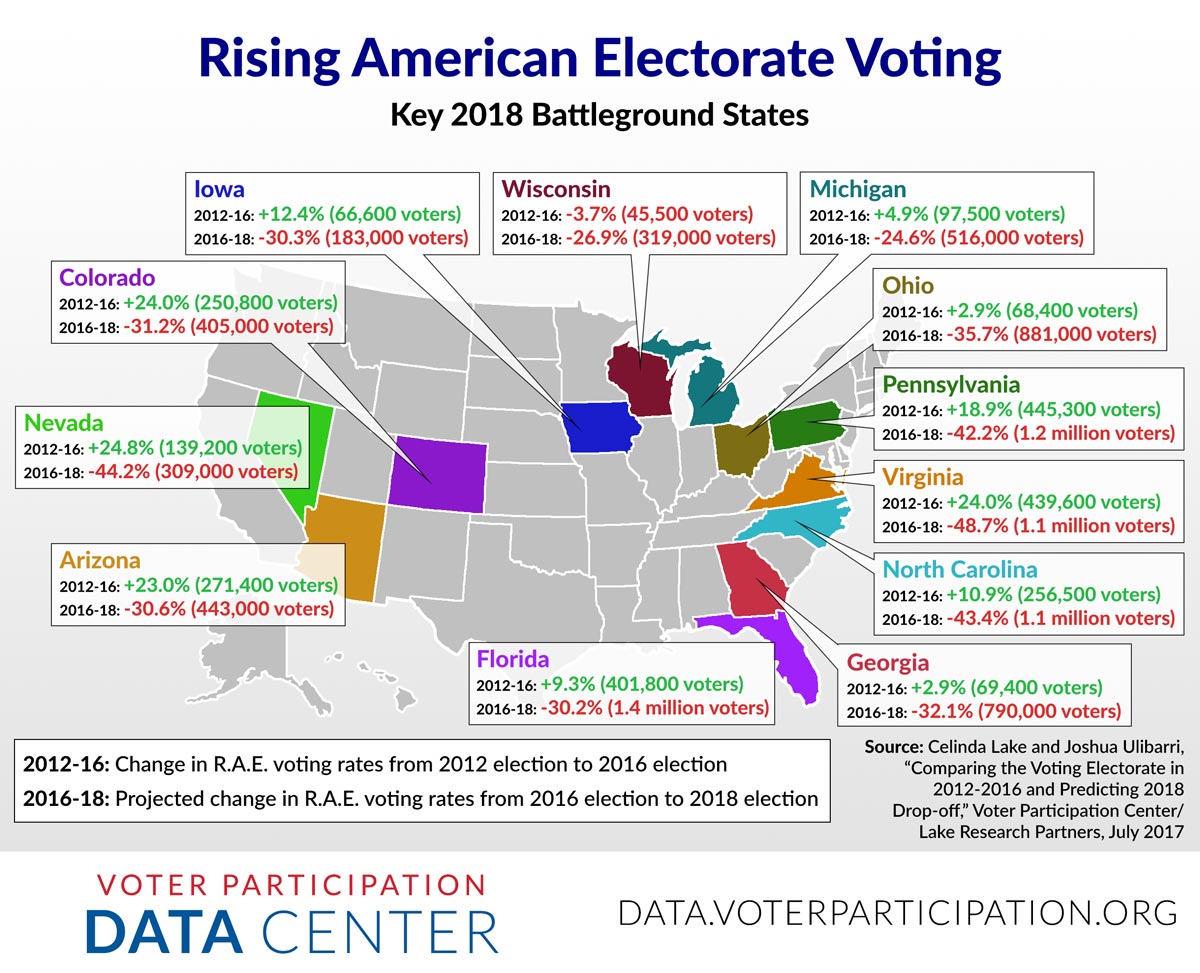Comparing the Voting Electorate in 2012-2016 and Predicting 2018 Drop-Off
As part of our ongoing efforts to understand the voting patterns of the Rising American Electorate, we’ve worked with Lake Research Partners to produce this report, which catalogues the changes in voting turnout for the Rising American Electorate between 2012 and 2016 – and makes projections for voter drop-off in 2018.
The projections are sobering and troubling to everyone who cares about increasing participation in our great democracy. Our prediction is that 40 million Americans who voted in 2016 won’t cast a ballot in the 2018 midterms — and to make matters worse, 2/3 of those drop-off voters will be members of the Rising American Electorate. The RAE dropoff is projected to be particularly pronounced in key 2018 battleground states, such as Arizona, Nevada, Florida, and Ohio:
Add in the effects of ongoing vote suppression efforts and the implication is clear: Democracy is facing a headwind in 2018. We need to double down on voter registration, mobilization and turnout efforts, and fighting for voting rights in order to make sure that every American has the opportunity to raise their voice at the ballot box.
Downloads
Unmarried Women: Growing in Numbers and the Power to Decide 2016 Elections
There are more than 58 million single women eligible to vote this November. For the first time ever, there are more single women than married women eligible to vote, and their numbers continue to grow nationally and in key states. And as the new poll of nine battleground states conducted for Women’s Voices Women Vote Action Fund shows, single women could determine the outcome of the presidential election and U.S. Senate races down-ballot.

Chart: Rising American Electorate vs. Non-RAE Percent Change
This chart showing the growth of the Rising American Electorate – unmarried women, people of color, and Millennials – in key states between 2010 and 2016 demonstrates quite clearly how broadly and quickly the face of America is changing.

All information was provided by Lake Research Partners.
2016 Primary Spotlight: Iowa
As we move through this primary season, the Voter Participation Center will profile unmarried women, their role in the electorate and economy in each of the contested states, starting with Iowa.
On February 1, the Iowa caucuses will provide a unique forum for civic engagement. The first official contest in the nominating process for President of the United States is an old-fashioned exercise in participatory democracy. On election night, voters go to designated precent locations to show their support for their candidates, listen to appeals for support from each campaign, and then vote. The caucuses first-in-the-nation position on the calendar gives the state enormous influence on the nation’s politics every four years.
So who shows up in the dead of the midwestern winter to shape America’s future?
Historically, according to an analysis from Drake University in Iowa, Republican caucus goers tend to skew heavily male; Democratic caucus goers tend to skew heavily female.
According to the most recent census data:
- Women make up slightly more than half of the Iowa population (50.8%)
- 45.4% of women in Iowa are unmarried
- Unmarried women make up 23 percent of the eligible voters in Iowa
- 62 percent of them are registered to vote
A detailed demographic analysis done for the Voter Participation Center shows that unmarried women have a large and vital economic stake in the outcome of the presidential election:
- Unmarried women are more likely than married women in Iowa to be unemployed
- Unmarried women are four times as likely to be living in poverty than married women
- Six in ten workers in Iowa who make minimum wage or less are women.
- Unmarried women earn less than other Iowans. They make 70.8 percent of what men earn; married women in Iowa make 80.8 percent of men’s earnings.
Next up: New Hampshire
New Data for the New Year
Here’s an updated look at the median earnings, health insurance coverage and poverty rates for unmarried women in 16 states. These profiles provide detailed demographic and economic portraits of the growing number of increasingly politically-powerful single women.
| California Colorado Florida Illinois |
Iowa Kentucky Missouri Nevada |
New Hampshire New York North Carolina Ohio |
Pennsylvania Texas Virginia Wisconsin |
Unmarried Women: The Key to Unlocking the New American Electorate
An astonishing number of single women aren’t yet registered to vote. If we help even a small percentage more of unmarried women register and vote, we’d likely see different results up and down the ballot in key 2016 states.
(Click on a state name in the table to view our demographic profile of unmarried women for that state.)
| State | Unmarried Women | % of Vote-Eligible Population | Registered to Vote | Not Registered to Vote |
| Colorado | 830,224 | 22% | 546,725 (66%) | 283,499 (34%) |
| Florida | 3,637,949 | 26% | 2,184,986 (60%) | 1,452,963 (40%) |
| Iowa | 524,096 | 23% | 325,929 (62%) | 198,167 (38%) |
| Missouri | 1,010,097 | 23% | 665,390 (66%) | 344,707 (34%) |
| Nevada | 482,278 | 26% | 266,875 (55%) | 215,404 (45%) |
| New Hampshire | 239,332 | 24% | 146,705 (61%) | 92,627 (39%) |
| North Carolina | 1,803,826 | 26% | 1,147,794 (64%) | 656,032 (36%) |
| Ohio | 2,171,933 | 26% | 1,341,439 (62%) | 830,495 (38%) |
| Pennsylvania | 2,296,628 | 24% | 1,404,064 (61%) | 892,563 (39%) |
| Virginia | 1,399,995 | 24% | 831,891 (59%) | 568,104 (41%) |
| Wisconsin | 1,007,304 | 24% | 637,094 (63%) | 370,210 (37%) |
Data Source: Current Population Survey: Voting and Registration Supplement, 2014. U.S. Department of Commerce, Bureau of the Census.
Statistical Profile of Unmarried Women: Iowa
Our research team has compiled available data from the US Census Bureau, the Bureau of Labor Statistics, and other sources to put together this statistical profile of the demographic and economic circumstances facing unmarried women in the state of Iowa.
Report updated August 2016


